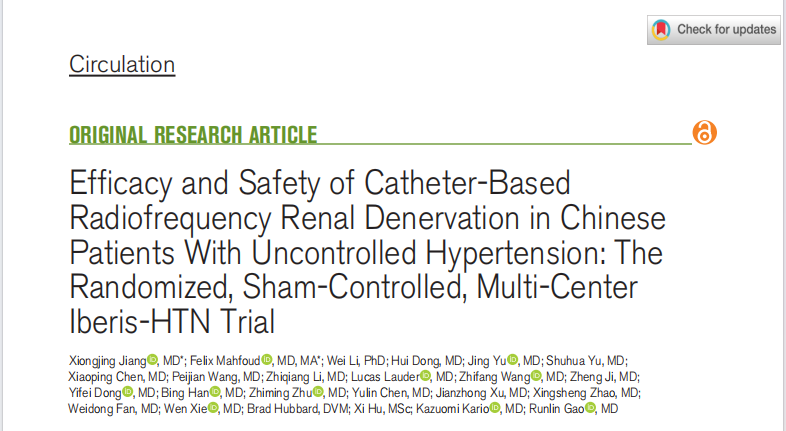
Major News! Circulatio:Effectness and Safety of Iberis® Radiofrequency RDN System for the Treatment of Uncontrolled Primary Hypertension
2024-11-19 11:39:24

On November 12, 2024, the Iberis-HTN study conducted by Academician Gao Runlin and Professor Jiang Xiongjing from Fuwai Hospital,CAMS&PUMC, together with numerous domestic experts, was officially published in the top international medical journal Circulation(IF: 35.5). Iberis-HTN studyconfirmedthat when using the Iberis®Multi-electrode Radiofrequency Renal Denervation CatheterSystem for RDN operation, at 6 months after the operation, thedecrease inthe 24-hour ambulatory SBPin the RDN group wassignificantly greater than that in the shamproceduregroup, and there wereno serious adverse events related to the instrument.
Study Design
Iberis-HTN is a prospective, multicenter, sham operation randomized clinical trial aimed at evaluating the safety and effectiveness of Iberis® Radiofrequency RDN System for the treatment of uncontrolled primary hypertension. A total of 873 patients with uncontrolled primary hypertension (previous clinic blood pressure ≥ 180/110mmHg) were recruited for the study. After 4 weeks of standardized antihypertensive treatment (taking three antihypertensive agentsfrom designated manufacturers), renal artery anatomical structure evaluation was performed. Patients with renal artery diameter ≥ 3mm and length ≥ 20mm were eligible for RDN operation. Ultimately, 217 patients met the inclusion criteria and were randomly assigned to either the RDN group (N=107) or the sham procedure control group (N=110). The average age of the two groups of patients was 45.3±10.2 yearsold, with 21% being female and an average BMI of 27.7±3.5kg/m2. At the time of entering the group, the proportion of patients taking three types of antihypertensive agentswas recorded as 96.3% in the RDN group and 98.2% in the sham procedure control group.
The primaryendpoint of the study was thechangeof24h mean ambulatory SBPat 6 monthsafter the operationrelative to 24hmean ambulatory SBP atbaseline. The secondary endpoints included: (1) changes of 24-hour mean ambulatory DBPat 6 monthsafter the operation; (2) changes ofclinic SBPat the 1, 3, and 6 monthsafter the operation; (3) the average number of antihypertensive agentsprescribed at the 1, 3, and 6 monthsafter the operation, as well as the proportion of patients with clinic SBP <140mmHg at the 6 monthsafter the operation. The safety endpointswere: (1) operativecomplications; (2) all-cause mortality rate; (3) cardiovascular events (including acute myocardial infarction or any coronary revascularization) and cerebrovascular events (including apoplexy, transient ischemic attack, and cerebrovascular accidents); (4) renal events, including eGFR<15ml/min/1.73m2, renal replacement therapy, renal artery re intervention or new renal artery stenosis (>50%), as well as other serious adverse events and adverse events.
Study Results
The results confirmed that compared with the sham procedure control group, the RDN group had a greater decrease in 24h ambulatory SBP (-13.0±12.1mmHg vs. -3.0±13.0mmHg)at6 months after RDN operation, and the between-group differenceinchange after the baseline was adjusted was -9.4mmHg (P<0.001). At the same time, the 24h meanambulatory DBP of the RDN group and the sham procedurecontrol group decreased by -7.7±8.6mmHg and -2.8±10.1mmHg respectively. The between-group difference in change after the baseline was adjusted was -5.0mmHg (P<0.001); the between-group differences in clinic SBPand DBPwere -6.4mmHg (P=0.003) and -5.1 mmHg (P=0.001), respectively. In addition, at the 6 monthsafter the operation, in the RDN group and the sham procedurecontrol group,the proportionsof patients with 24hABPM<130/80mmHg were 29.2% and 7.5%, respectively; the proportionsof patients with clinic SBP<140mmHg were55.7% and 37.7%, respectively.
In terms of safety, one patient in the RDN group developed complications (hematoma) at the puncture site, but recovered without any after-effects. During the follow-up period, neither group of patients developed new renal artery stenosis>50%, nor did any patients develop end-stage renal disease.
Regarding the RDN operation: The average operation duration for the RDN group was 69.4 ± 32.9 minutes. All patients who underwent RDN operation successfully underwent bilateral operation. The left and right renal arteries underwent 6.2±2.2 and 6.4±1.9 ablation cycles, respectively, with each ablation cycle consisting of 4 ablation points.
Regarding changes in antihypertensive agentsand compliance: There was no difference in the average number of antihypertensive agentsprescribed between the treatment groups at baseline and all follow-up time points. At the 6-month, the average numbers of antihypertensive agentsprescribed in the RDN group and sham procedurecontrol group were 3.0±0.2 and 3.1±0.7(P=0.166), respectively. There was no difference between the groups when considering drug categories and drug doses.
StudyConclusion
The analysis results indicate that it is safe to usethe Iberis® Radiofrequency RDN Catheter System for RDN operation, and blood pressure can be maintained to continuouslydecreaseduring the day and night at the6 monthsafter operation, and the ‘always-on-effect’ of blood pressure seems to be unrelated to drug intake. Compared with previous RDN studies, the patients in the Iberis-HTN study were younger (average age of 45 yearsold)withhigher heart rates (average heart rate of 79 beats per minute), indicating that RDN is more effective in young and heart rate increasing patients. In addition, from the perspective of equipment usage, the Iberis® RadiofrequencyRDN Catheter System is compatible with 6-French guidingcatheters and has a ring-shaped tinewith 4 independent ablation electrodes, which helps to reliably contact the wall and perform circular treatment on renal arteries with diameters of 3~8mm. It is currently the only RDN catheter with CE mark andtransradial arteryapproach. At present, safety studies on transradialarteryand transfemoral artery approaches are also in progress. For the study population, the Iberis-HTN study only enrolled patients with normal renal function or mild to moderate decline. In the future, the effectiveness and safety ofthe Iberis® Radiofrequency RDN Catheter System need to be validated in a wider population.

Academician Gao Runlin from Fuwai Hospital, CAMS & PUMC
Based on the past experience, Iberis-HTN studyhas innovatively upgraded the catheter equipment, transforming it from a single electrode to a ring-shapemulti-electrode automatic wall ablation catheter, significantly improving compliance, passability, and wall adhesion performance. It is perfectly compatible with 6F guidingcatheter and can achieve sufficient ablation of renal artery and its branches, as well as accessory renal artery.
The Iberis-HTN study results showed that therewasa decrease of 9.4mmHg (P<0.0001) in 24-hour ambulatory SBP at6-month follow-up in RDN group, with significantdifferencecompared to the sham proceduregroup. At the same time, therewerealsodecreases forsecondary indicators such as 24-hour ambulatory DBP and clinic blood pressure in RDN group, with good safety and no serious adverse reactions related to the experimental equipment, confirming that the Iberis® Radiofrequency Ablation System is effective and safe for treating primary hypertension.
From the perspective of the studypopulation, the Iberis-HTN study still has certain limitations, only including patients with normal renal function or mild to moderate decline. Future studiesneed to refine the screening of suitable populations in order to achieve better therapeutic effects. It is worth mentioning that the Iberis® catheter, as the only RDN product in the world withtransradialartery approach,provides doctors and patients with more choices and lays the foundation for future day-operation, reducing treatment costs, minimizing complications, and optimizing patient experience. It is expected that in the future, RDN can bring good news to more hypertensive patients who still cannot effectively control their blood pressure after lifestyle adjustments and medication treatment, helping them achieve good blood pressure control and improve their quality of life.

Professor Jiang Xiongjing from Fuwai Hospital, CAMS & PUMC
The Iberis-HTN study was designed to select the change in 24-hour ambulatory SBP compared to baseline as the mainclinical endpoint. The 24-hour ABPMcan more accurately reflect blood pressure fluctuations compared to clinic blood pressure, effectively avoiding potential interference from the clinic environment on blood pressure measurement. It is in line with internationally recognized hypertension treatment evaluation standards, ensuring the reliability of studyresults. At the same time, in order to further eliminate the interference of drug factors on the experimental results, the Iberis-HTN study strictly limited the use of three types of antihypertensive agentsfrom fixed manufacturers and brands from preoperative screening to 6 months after the operation, and evaluated medication compliance through detailed records of patient medication and urine tests to ensure that there was no significant difference in medication compliance between the two groups.
In terms of instrument selection, considering the importance of high-quality four-quadrant ablation in effectively killing more renal sympathetic nerves and achieving greater blood pressure reduction in the renal arteries that fluctuate with respiration, the Iberis-HTN study usedthe Iberis®Multi-electrode Renal Artery Radiofrequency Ablation Catheter Systemwith a four electrode ring-shapeablation design. This system can transmit energy to the renal artery wall more stably and reliably, not only ensuring the prognostic effect, but also reducing the requirements for operator’s skills. In addition, the Iberis® ablation device supports RDN treatment via the transradial artery approach, opening up a new treatment pathway for hypertensive patients whose transfemoral artery approachis not feasible. The radial artery approach, with its low incidence of complications, excellent patient experience, and support for day-operation, can further enhance the safety and convenience of treatment.

Academician Gao Runlin
Fuwai Hospital, CAMS & PUMC
Academician of the Chinese Academy of Engineering(CAE). Academician Gao Runlincurrently serves as the Professor and Doctoral Supervisor at the National Center for Cardiovascular Disease(NCCD), the Chinese Academy of Medical Sciences, and the Fuwai Hospital of Peking Union Medical College. He formerly served as the President of the hospital, Chairman of the Chinese Society of Cardiology(CSC), Vice President of the Chinese Medical Doctor Association, and Editor in Chief of the National Medical Journal of Chinaand the Chinese Journal of Cardiology. He currently serves as the Executive Director of the Chinese Medical Association and Editor in Chief of the Chinese Circulation Journal, the Editorial Board Member of European Heart Journal, Journal of American College of Cardiology(JACC) Cardiovascular Intervention, JACC Asia, Asiaintervention,Cardiology Discovery, and the Senior Consultant Editorial Board Member of EuroIntervention,and the Fellow of the American College of Cardiology, European Society of Cardiology, and Society for Cardiovascular Angiography and Interventions(SCAI).

Professor Jiang Xiongjing
Fuwai Hospital, CAMS & PUMC
Professor Jiang Xiongjing currently servesas the Deputy Director of the Vascular Center, Director of the First Ward of the Vascular Center at Fuwai Hospital, CAMS & PUMC, Chief Physician,Standing Committee Member of the Peripheral Vascular Disease Group of the Asia Pacific Society for Interventional Cardiology, Executive Director and Deputy Secretary General of the China Hypertension League,Standing Committee Member of the Peripheral Vascular Disease Group of the Asia Pacific Society of Interventional Cardiology, Executive Editorial Board Member of the Chinese Journal of Hypertension, Member of the International Society of Hypertension, Editorial Board Member of the Chinese Circulation Journal, Member of the American Society of Hypertension, Executive Director of the Cardiovascular Disease Branch of the Beijing Medical Doctor Association, Chairman of the Vascular Disease Hypertension Branch of the China International Exchange and Promotive Association for Medical and Health Care, Expert of the International Society of Endovascular Intervention (ISES), and Editorial Board Member of the Chinese Medical Journal (Chinese and English edition).